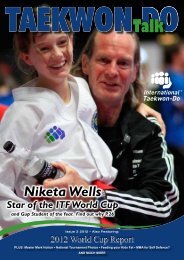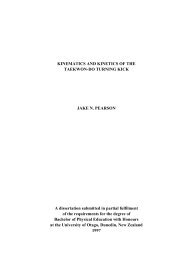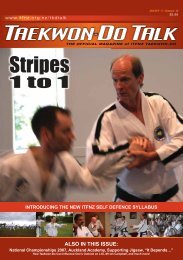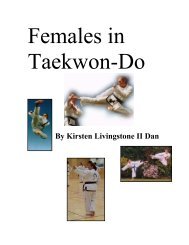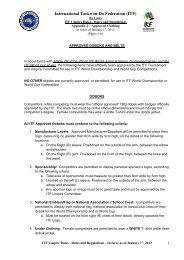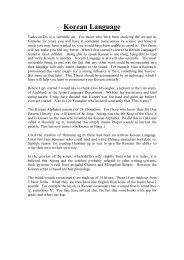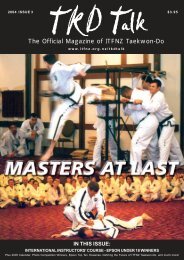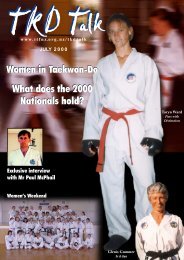WORLD CAMP 2000 - International Taekwon-do Federation of New ...
WORLD CAMP 2000 - International Taekwon-do Federation of New ...
WORLD CAMP 2000 - International Taekwon-do Federation of New ...
- No tags were found...
Create successful ePaper yourself
Turn your PDF publications into a flip-book with our unique Google optimized e-Paper software.
Tests <strong>of</strong> fitness showed less <strong>of</strong> a distinction between the walking groups. Measurements<strong>of</strong> reductions in heart rate and blood lactate, a chemical that causes fatigue in muscles,were less clear cut but all three walking groups were a lot fitter than the control group.So the message is clear, daily walks can help extend your life. If long walks are notalways possible on your <strong>of</strong>f days in between training, then try leaving your car somedistance from your place <strong>of</strong> work and walking the rest <strong>of</strong> the way. How about walkingduring your lunchtime? And the same goes for school kids. Get Mum to drop you <strong>of</strong>ffurther away from school rather than at the gate. Putting your feet up in front <strong>of</strong> theTV with a bag <strong>of</strong> chips sucks – try the walk <strong>of</strong> life.Skip the Warm UpDon’t bother warming up before training because it won’t stop you from getting injured.So said a news article that made the headlines just before Christmas. The news raiseda few eyebrows and so some explanation was required.The discovery was announced as a result <strong>of</strong> a scientific study conducted by an Armyphysiotherapist. Rod Pope and colleagues, while working out <strong>of</strong> the University <strong>of</strong> Sydneyand Charles Sturt University, conducted a year long study <strong>of</strong> more than 2600 armyrecruits. The group was divided into two, with one group stretching particular legmuscles before exercise while the other did not stretch. The researchers found thatthere was no difference in the injury rates between the two groups.Unfortunately we were not told what type <strong>of</strong> stretching was <strong>do</strong>ne in the trial. Assumingthat the stretching was static then the results probably make sense. Static stretchingis the type where a limb is kept still while the muscle is slowly taken through its fullrange <strong>of</strong> motion. Static stretching can be harmful, as some evidence suggests thatstatic stretching <strong>do</strong>ne before dynamic exercise like <strong>Taekwon</strong>-Do movements, can actuallyincrease the chance <strong>of</strong> injury. This is because static stretching relaxes and cools <strong>do</strong>wnmuscles and makes them less responsive to stimulation. This is the complete opposite<strong>of</strong> what we are trying to achieve by <strong>do</strong>ing a warm up, which is preventing injury andpreparing the body for activity.Pope and his colleagues are now telling the army to not bother with stretching.Personally I would qualify that and say not to bother with static stretching during thewarm up, unless someone was chronically tight in a particular muscle. A popular andsafer approach these days is to warm up with dynamic stretching like arm swings andleg swinging. As long as it is <strong>do</strong>ne gently at first, dynamic stretching is better becauseit warms up the muscles with movements that are similar to proper <strong>Taekwon</strong>-Domovements. The correct place for static stretching is during the cool <strong>do</strong>wn phase at theend <strong>of</strong> training, where excited muscles are calmed, stretched and waste productsremoved.Pope’s study was reported <strong>New</strong>Scientist magazine (18 December 1999). Theinvestigation has been accepted for publication in a scientific journal, which meansthat the findings are not to be sneezed at.Mike Lowe16



